How to Put a Worm on a Hook

Worms and nightcrawlers are two of the most effective fishing baits on earth. Just about any freshwater gamefish will eat a worm. For those who don't know how to properly bait a worm on their hook, this guide is for you.
I know this is a bit random, but if you ever wanted to go on a guided or chartered fishing trip in freshwater or saltwater, you should check out Fishing Booker. They are the leading database of certified and professional fishing guides at the guaranteed lowest prices. They have countless listings for such dream destinations as the Florida Keys, Corpus Christi, Great Lakes, San Diego, Central America, Montana, and many more. Click here to visit Fishing Booker and book your trip of a lifetime at very affordable prices.
Basic Guideline on How to Bait a Worm on the Hook
- Select the proper hook
- Make sure the hook is properly tied on your line
- Grab a healthy, active worm or nightcrawler from a container
- Run your hook into the mid-section of the worm
- Pull the hook through the worm
- Repeat this process until it has been hooked 2-3X
- Leave the head and/or tail to dangle free
- Wipe the dirt off your hands
- Attach lead split shots and bobber strike indicator as desired
- Cast your bait where your target species lives
- Repeat this process with each worm
Now that is just the generic how-to hooking guide so you understand the concept. It is definitely not species-specific. In this article, I have produces a quick how-to guide for a variety of species since a one-size-fits-all approach does not work for all freshwater species with worms.
What You 'll Need
- Can of worms or nightcrawlers
- Fishing Rod/Reel/Appropriate Fishing Line
- Appropriate Hook for Your Target Fish
- 2-4 oz lead for catfish and striped bass
- Lead worm head for Largemouth Bass
- Optional: Bobber float and split shot weights
Selecting the Proper Hook for Your Fish
I wrote a very helpful fishing hook selection guide which you really should check out. But for the sake of this article, let's keep it simple. For most of the fish on this list, a simple j-hook or bait hook will work great. Note: for catfish, drum, and carp, I would recommend you go with a circle hook. For largemouth bass, a worm hook is required.
Hook Sizes:
Carp: size 3 through 1
Catfish: size 2 through 6/0
Bullheads: size 7 through 1
Striped Bass: size 1/0 through 4/0
Largemouth Bass: size 5 through 4/0
Crappie (White & Black): size 5 through 4
Bluegills: size 8 through 5
Sunfish: size 6 through 4
Freshwater Drum: size 2 through 1/0
Rainbow Trout: size 6 through 1
Brown Trout: size 4 through 1
Brook Trout: size 8 through 4
Suckers: size 8 through 6
Walleye: Size 3 through 2/0
For a complete breakdown of which fish you can catch using worms, check out this article. It is loaded with useful and actionable information to catch you more fish using worm as bait.
How to Bait a Worm on the Hook for Trout & Panfish
Trout and Panfish have relatively small mouths for their body size so a full nightcrawler would be too much food for all but the largest of trout. For trout, go with 1/2 a nightcrawler or a full red worm. For panfish, 1/2 a red worm and 1/4 of a nightcrawler would be ideal.
Hook Needed:
Trout: j-hook or bait hook; size 8 through 1
Panfish: j-hook or bait hook; size 8 through 4
Gamakatsu Baitholder Hook
These baitholder hooks by Gamakatsu are premium-quality hooks that offer enough flexibility to prevent breaking but are sharp enough for any task. Gamakatsu makes the best affordable fish hooks on the market and this line of baitholder hooks for trout and panfish is elite.
Step 1: Ensure you have the right fishing hook for your species of fish on the time. Reference the above section for this guidance.
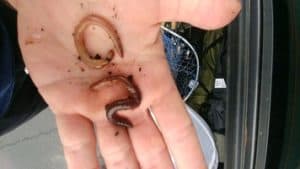
Tie the hook onto your live using the knot of your choosing. I recommend a clinch knot but find myself being lazy and just doing a quadruple overhand knot. Make sure the knot is secure by pulling on the hook to ensure it doesn't slip through the eyelet of the hook. Snip off the "tag-end" of the line from the knot.
Step 2: Grab a healthy red worm or nightcrawler from your container.
If you are fishing for trout, break the nightcrawler in half or keep the red worm fully intact. If fishing for panfish, break a quarter of the nightcrawler off or use half the red worms.
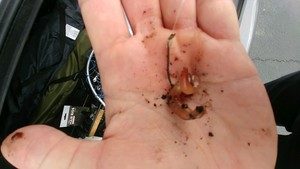
Step 3: Run the point of the hook through the worm or nightcrawler multiple times. With each hole you put in the worm, that will be one additional pore for fish-attracting scent to come out of. I recommend leaving the head or the tail of the worm free to dangle off the hook. This free section will continue to wiggle freely which will visually attract the attention of hungry panfish and trout.
Step 4: Add a desired amount of split shot lead weights to sink your bait, get better casting distance, and also to ground your bait in a strong current. When adding split shots, make sure you attach them 4-8 inches above your bait. This will allow your worm to suspend off the bottom where fish can better see and attack it.
You can also add a bobber or strike indicator float to detect subtle bites. Bobbers can be useful for trout but really are important when fishing for panfish who are notorious for subtle bites and swallowed hooks.
Step 5: Cast these worm-baited hooks in areas of water where trout and panfish linger. For panfish, docks, weedlines, and under bridges are good starting spots. Trout can be found in eddies and slower water near faster moving current in rivers and streams.
How to Bait a Worm on the Hook for Carp, Catfish, Bullheads, Striped Bass, & Freshwater Drum
For these species of fish, you're going to need more meat on the hook to get their attention. Catfish and bullheads, in particular, have poor eyesight and rely on their senses of smell and touch to locate worms. Give them plenty to detect. I would go with a full nightcrawler or 2-3 complete red worms. These should be enough bait to catch most species in this section. With bullheads, you could still catch some using a half nightcrawler as they are generally smaller in size than catfish.
Hook Needed:
Catfish: circle hook, bait hook, or octopus hook; size 2 through 6/0
Bullheads: circle hook or bait hook; size 7 through 1
Freshwater Drum: circle hook or octopus hook; size 2 through 1/0
Striped Bass: circle hook or bait hook; size 1/0 through 4/0
Carp : circle hook or bait hook; size 3 through 1
Step 1: Ensure you have the right fishing hook for your species of fish on the time. Reference the above section for this guidance.
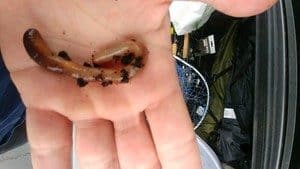
Tie the hook onto your live using the knot of your choosing. I recommend a clinch knot but find myself being lazy and just doing a quadruple overhand knot. Make sure the knot is secure by pulling on the hook to ensure it doesn't slip through the eyelet of the hook.
Snip off the "tag-end" of the line from the knot. Knot strength is very important for these fish as they are very strong. A Palomar knot or clinch knot will be your best bet.
Step 2: Grab a healthy nightcrawler or a few red worms from your container. For catfish 1 and even 2 full nightcrawlers is recommended.
Bullheads will want 2 red worms or a half a nightcrawler for best results. For freshwater drum, striped bass, and carp, go with a full nightcrawler or 2-3 red worms depending on their size.
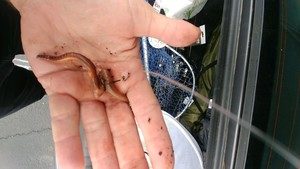
Step 3: Run the point of the hook through the worms or nightcrawler multiple times. With each hole you put in each worm, that will be one additional pore for fish-attracting scent to come out of.
I recommend leaving the head or the tail of the worm free to dangle off the hook. This free section will continue to wiggle freely which will visually attract the attention of hungry predatory fish.
Step 4: You are going to want to add a considerable amount of lead weights to your line. This is especially true if you are fishing in a system with a strong current like I do when I target striped bass and catfish in the canals.
You will need to keep your bait in one place on the bottom. If you don't use enough weight, the current will drag your bait and you'll get snags and tangles like crazy. As an example, when I fish the 'duct', I use 4 oz pyramid weights to keep it down.
Step 5: Cast your baits in areas where your target species is likely to be. Often times this means deep water 20-50 feet from shore.
For a complete gear and tackle recommendation for catfish, check out my recommended catfish gear list which will help you catch more and larger catfish than anyone else.
How to Bait a Worm on the Hook For Largemouth Bass & Walleye
Largemouth bass and walleye are special cases. Don't bunch up the worms on their hooks like you would any other species with multiple hook holes. Instead, you want one single entry and exit hole with these 2 species. Everyone knows bass fishermen have a lot of success fishing with soft plastic worms.
Well, that is exactly how you are going to rig real nightcrawlers. With walleye, one of the most effective ways of catching them is by hooking a nightcrawler through the head and trolling it along the bottom with a sliding lead weight.
Hook Needed:
Largemouth Bass: worm hook; 5 through 4/0
Walleye: bait hook or standard j-hook; size 3 through 2/0
Step 1: Ensure you have the right fishing hook for your species of fish on the time. Reference the above section for this guidance.

Tie the hook onto your live using the knot of your choosing. I recommend a clinch knot but find myself being lazy and just doing a quadruple overhand knot. Make sure the knot is secure by pulling on the hook to ensure it doesn't slip through the eyelet of the hook.
Snip off the "tag-end" of the line from the knot. Knot strength is not as important with these fish as it is with catfish, drum, and striped bass. Bass and walleye aren't nearly as powerful so you can usually get away with a lesser knot.
Step 2: Grab a healthy, lively nightcrawler from your container. If it's damaged in any way, toss it aside. Only grab the best looking ones in the container. We will be using the complete nightcrawler here. Do not break the worm in half unless you are targeting small bass or walleye.
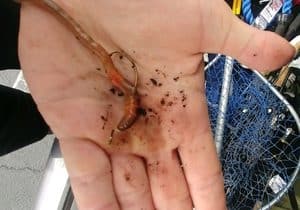
Step 3: Grab your hook and the nightcrawler.
Bass: Gently thread your worm hook through the "nose" of the worm, through the head, and out just like you would a plastic worm. Pull the full bend of the hook out of the crawler's body and then turn the hook point back into the worm.
Embed the hook point slightly into the worm's flesh to make it weedless. This will look exactly like how you rig a soft plastic worm except it will produce a more attractive scent for bass.
Walleye: Thread your hook through the nose of the nightcrawler just as you would for the bass but since your hook is a lot smaller, it will only run through a small section of the crawler's head.
Leave the hook point exposed as weed-prevention is not an issue for deep-trolling walleye. Let that hook point stick way out of the worm to ensure good, strong hook sets on these toothy fish.
Step 4: Make Sure you have the appropriate lead weights for this fishing. You can rig your bass worm to fish a variety of different ways but Texas rig and Carolina rigs are the most popular and usually the most effective.
Step 5: Fish water where your target fish lives. For bass, focus on shallow-to-middle depth cover like rock pilings, docks, timber, weeds, and stumps. Walleye usually will prefer deeper channels and deep cover like boulders.
Selecting the right gear and bait for bass is vital. For a comprehensive breakdown of the best rods, reels, electronics, line, and baits for bass fishing, check out my recommended bass fishing gear list. Always be the most prepared and equipped angler on the water.
Important Guidelines to Follow
What to do with your hands
I've read some other articles on this topic that recommends rubbing dirt on your hands before touching worms to eliminate your human smell. Another site recommended washing them with soap. All that tells me is they don't really fish and they are looking for more bullet points to write about. You don't need to wash your hands or make them super dirty?
Fish love worms. I've never washed my hands prior to grabbing a worm and never had trouble catching fish. Why go through 20 steps to get to the same result you can with 1? Someone else recommended making your hands cold before grabbing the worm? What the heck?! Forget all that garbage. Just grab the worm and start baiting it. Don't overthink it.
Match the Bait with the Bites
If you start losing your worms and getting bites without hook sets, either your bait or hook is too big. Potentially both. Systematically downsize your hook and piece of worm until you stop losing bait and you start having solid hooksets.
Choose Healthy Worms
If the worms are looking half-dead, they'll likely draw little interest from fish. Pick the healthiest, most active worms possible. If you are buying from a bait shop, you won't have a choice but if you can pick your own, get healthy ones.
Worms vs. Nightcrawlers
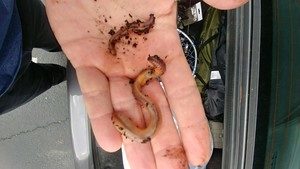
Worms and nightcrawlers are popular bait for almost all freshwater game species. Why is that? That's because all fish like eating worms. I find this a bit ironic since most fish will never see a worm in their lifetime unless there is a hook attached to it.
Worms and nightcrawlers drown in water so the only way a fish will ever see a worm in its everyday life would be if a worm got washed into the water by flooding or if a kid threw some worms into the water. Worms aren't just crawling along the bottom of ponds as ready-made fish food.
So are nightcrawlers or worms the better option? If you are buying bait, go with nightcrawlers as they are much larger and often in better shape than redworms you buy in the store. If you have access to worms from your backyard, hands down they will out-fish nightcrawlers under most situations.
1. Nightcrawlers: If you are going to be buying your worms, go with nightcrawlers. These baits are huge and are usually kept in very good shape before purchase. When you compare them to your typical redworm or blood worm found in stores, they are meatier and usually more lively. Liveliness I believe is the key to a good worm as fishing bait. You want a worm that will wiggle and move about while on the hook. The scent plus that action is what will draw in fish.
Regarding the large size of crawlers, if you are fishing for panfish or trout, it is advised you break off pieces of the nightcrawler and avoid using the full creature. These fish have smaller mouths and can't fit an entire nightcrawler in their mouths. Using a full nightcrawler for panfish and trout will result in a lot of stolen bait but few hookups.
2. Store-Bought Worms: This would be my least favorite choice since store-bought worms, at least from my experience, tend to be of the lowest quality. They are typically smaller than you expect, they aren't in as good of shape as nightcrawers, and they aren't anywhere near as lively on the hook as nightcrawlers.
They will certainly still catch fish but they would be my least favorite option. Many of these worms are so small, you may need to double and even triple up a hook with worms especially when targeting catfish, drum, and striped bass.
3. Garden or Backyard Worms: Of all three of these options, this would be my absolute favorite option. Yes, they are less convenient to acquire than store-sold worms and crawlers but they will out-fish them 8/10 based on personal experience. You can find worms after a rainstorm or by digging loosely in mulch piles, flipping rocks, or simply overturning some grass.
Worms you find in the "wild" will be meatier than store-sold worms, will be in a lot better condition, and most importantly, they will be very lively and wiggle freely on the hook. They may take a little extra effort to acquire them, but they are well worth the time to use.
Source: https://freshwaterfishingadvice.com/how-to-bait-worm-on-hook/